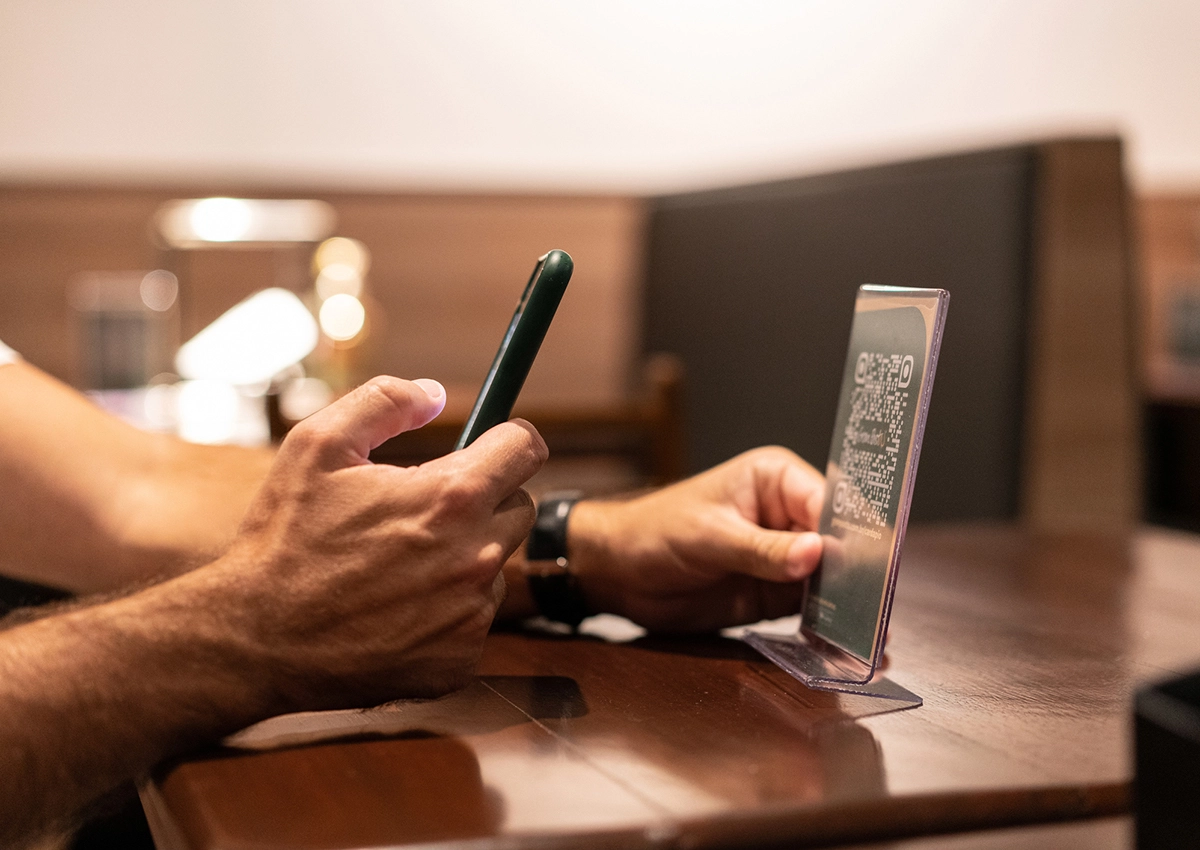Welcome to the digital age of dining, where QR codes are becoming the cornerstone of a modern, efficient, and engaging restaurant experience. A 2022 Deloitte Study found that consumers spend an incredible 20% more when ordering through technology like tableside ordering, online menus, and handheld POS devices. Implementing QR code ordering is one of the fastest ways to quickly implement digital ordering. These compact, square-shaped pixel blocks hold the power to transform your restaurant into a more efficient business where owners, customers, kitchen staff, and the front-of-house enjoy smoother shifts and higher earnings.
From faster ordering and bill pay to instant marketing impact, QR codes remove costly steps in your operations and give your customers the tools to create their own individual experience – right from their personal devices.
Let’s explore QR codes in depth: What they are, how they work, and how you can unlock their potential for your business.
Restaurant QR codes for beginners
If you’re more familiar with jotting down orders on a notepad than tapping on a screen, the concept of QR codes might seem like a complex, costly investment. Fortunately, working with them is simple.
What is a QR code?
QR codes are essentially a bridge between the physical and digital worlds. Restaurants place printed codes — pixelated squares — at tables, on the host stand, on bars, wherever diners hang out. By scanning codes with a smartphone, customers are taken to your digital content instantly — be it menus, special offers, or even your social media pages.
Why are restaurants using QR codes?
This shift from pen and paper to digital interaction not only streamlines the dining experience but also opens up a treasure trove of marketing opportunities, from promoting email signups to loyalty programs to seamlessly gathering online QR code payments.
Should I start using QR codes in my restaurant?
Even using QR codes for 1-2 functions like daily menus or following on social media eliminates time-consuming tasks for you and your staff. Does this eliminate the personal touch in dining? Absolutely not. Customers still expect great service and amazing food. Ditching the notepad frees your staff up to offer warm greetings, answer questions, and get started on the cup of coffee for the regular who just wandered in.
Setting up QR code table ordering systems
A step-by-step guide
Not sure how to start using QR codes at your restaurant? There are so many options out there!
From integrated to DIY to everything in between, these are the steps to setting up QR codes for menus:
- Choose a QR code generator: Start by selecting a QR code generator that suits your needs. Look for features like customization, tracking, and ease of use.
- Post your menu on a website page. Make it clear, easy to read, and mobile-device friendly. Think big fonts and labeled between sections. Your customers will order more if they can easily find what they want!
- Create your QR code: If possible, customize your QR code design to reflect your brand – think colors, logo, and style.
- Link to your digital menu: Connect the QR code to the URL where you’re hosting your digital menu. Ensure your online menu is updated, visually appealing, and user-friendly.
- Test the QR code: Before rolling it out, test the QR code on multiple mobile devices to ensure it directs to the right webpage and loads efficiently.
- Educate your staff: Train your staff in how the QR code system works so they can assist customers if needed. Diners may have trouble scanning, bad connectivity, or privacy concerns. Many people have accessibility barriers to using some devices. Oftentimes, new diners don’t even realize that they need to look for a code and expect to be handed a menu! Be ready with traditional options or an extra moment to explain tech. The time saved on menus for the majority of your guests more than makes up for these moments of personalized service.
- Place QR codes on tables: Place the QR code strategically on each table – think tent cards, table stickers, or integrated into the table design. Even a little business card in a stand provides a discreet and attractive option.
- Gather feedback and iterate: Collect customer feedback on their experience and make improvements as needed.
- Integrate digital systems: Once you have operational codes in your restaurant, consider how they can power the rest of your point-of-sale system, from digital ordering to payment to customer loyalty. We’ll get into that shortly. Once you’ve set up your physical space and how you’ll work with the new system, it’s time to think about all the ways QR codes will work on the digital experience side.
Save 30%+ on labor costs using QR codes with handheld POS systems
With significant potential labor savings from transitioning to integrated QR-code based ordering, it’s no surprise that 85% of hospitality leaders prioritize integration across systems when working with their POS. QR codes are one of the easiest ways to link multiple systems.
Eliminating the menu drop is just the first step. The real magic happens when QR codes work in tandem with handheld POS systems. It’s like having a personal waiter for each customer. Customers scan, order, and pay without the need for a physical menu or waiting for a server. On the backend, orders go directly into your POS system, streamlining the kitchen’s workflow and reducing wait times. This integration not only enhances efficiency but also elevates the customer experience, making your restaurant a preferred choice for diners.
Using QR codes for digital menus
Digital menus are the new normal, and QR codes are your gateway. With a quick scan, customers have your entire menu at their fingertips – updated in real-time and rich with mouth-watering images and descriptions. This not only saves costs on printing but also allows you to tweak and update your offerings on the fly, keeping your menu as fresh as your ingredients.
Contactless ordering and payment with QR codes
In a world where contactless interactions have become valued, QR codes stand out as indispensable tools enabling frictionless ordering on customer devices. They enable customers to order and pay without physical contact, offering peace of mind alongside convenience. This feature is particularly crucial in the post-pandemic era, where safety is as important as the food itself.
Creative uses of QR codes in restaurant settings
Beyond menus and payments, QR codes can be woven into the very fabric of your restaurant’s atmosphere. Here are some ideas for “easter egg” bonus experiences that can deepen diner engagement and provide something special:
Behind-the-scenes: meet the chef making your food, hear the story of a recipe, or discover the farmer or supplier who delivers the freshest ingredients. Post a few photos with captions, or shoot a 30-second video where one of your people explains a specialty of the house.
Recipes: scan a QR code near the bar for step-by-step instructions for a favorite cocktail.
Secret menu items: have a fun, unusual, or unexpected substitution that people don’t know about. Hide a QR code somewhere with a little hint about what’s behind it. “Love chicken? Then you’ll love…” you get the idea.
These little touches add inspiration, authenticity, and real human stories to your establishment and can set your restaurant apart from the competition.
How restaurant QR codes work beyond the dining room
Powering marketing & promotions with QR codes
54% of restaurant operators report using digital POS systems to power promotions. With QR codes linking your dining experience to your digital POS, restaurants can reach customers with promotions while they’re seated and engaged. QR codes make this a reality. They can link to special deals, event tickets, or limited-time offers. This real-time marketing is direct and effective, turning the casual diner into a loyal patron.
Leveraging QR codes for customer loyalty programs
A Deloitte study found that 40% of customers want to hear from a restaurant once a month or more. They prefer that 80% of these interactions be about discounts and special offers. That is significant loyalty. Customer loyalty is gold, and QR codes are your mining tools. Use QR codes on receipts, placards, and marketing materials—anywhere curious (or recently satisfied) customers might interact. Give them an enticing offer for signing up and make earning rewards a seamless part of the dining experience.
Customers can easily sign up, check their points, and redeem rewards while enjoying their meal. This hassle-free approach to loyalty programs not only boosts customer retention but also enhances the overall dining experience.
Using QR codes to collect feedback
Feedback is crucial, and QR codes streamline this process. By linking a feedback form to a QR code, you can encourage customers to share their experiences in real time. This immediate feedback loop allows you to address any issues promptly and continuously improve your service.
Social media integration with QR codes
According to Harvard Business Review, a five-star rating can have as much as a 10% impact on a restaurant’s revenue. A strong social media presence is a vital tool for a restaurant’s ongoing marketing in order to power ongoing social proof that your establishment is worth visiting. QR codes can bridge your physical location and your online persona. Linking QR codes to your social media profiles or hashtags can increase your online visibility and engagement, turning every diner into a potential online advocate for your brand.
QR code analytics for restaurant marketing
Codes aren’t just about convenience; they’re a goldmine of data. By tracking the scans, you can gather valuable insights into customer behavior and preferences. This data can inform your restaurant marketing strategies, allowing you to tailor your efforts for maximum impact.
Ready to start using QR codes in your restaurant?
Here are some pointers for implementing these technologies to realize their full potential and streamline their introduction into your restaurant.
Training staff for QR code implementation
For QR codes to succeed, your staff needs to be on board, and training is key. Take a deep breath. This is new! Schedule 2-3 time periods before shifts to educate staff. You’ll want to cover these fundamental topics:
Start with the customer. If they aren’t familiar with QR codes, it’s our job to help walk them through the process (or hand them a backup paper menu!) With friendly guidance and encouragement, it’s easy to win them over (and see bigger orders and tips) without much fuss.
Cover the back-end technology. Discuss how orders will flow and how to keep track of tickets in progress.
Discuss adapting workflows. Who covers food running, answering questions, prepping place settings, and the like? Staff who adapt to QR code ordering tend to find themselves freed up to take better care of customers. Discuss ways they can do this!
Promote offers, surveys, and loyalty. Staff who are knowledgeable and enthusiastic about this QR code technology can greatly influence its adoption and effectiveness and bring about all the efficiency and revenue benefits they can unlock.
Why QR codes are a vital tool for restaurants today
QR codes are more than just a technological trend; they are a vital tool in modernizing your restaurant’s business. From the dining experience to marketing and customer engagement to data analytics that improve your offerings, the benefits are extensive and multifaceted. Embrace these digital wonders and watch as they transform your restaurant into a hub of innovation and customer satisfaction.
QR code payments made easy with CAKE
Implementing QR codes for tableside ordering to power growth at your restaurant is easier with CAKE. Our integrated POS platform seamlessly integrates with all of your essential functions. From payment processing to loyalty, CAKE enables connected experiences wherever a customer interacts with your establishment.







